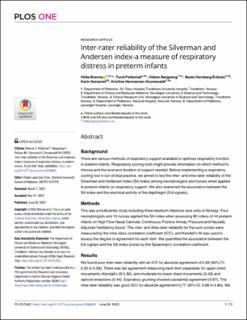| dc.contributor.author | Brenne, Hilde Birgitte Hansen | |
| dc.contributor.author | Follestad, Turid | |
| dc.contributor.author | Bergseng, Håkon | |
| dc.contributor.author | Eriksen, Beate Horsberg | |
| dc.contributor.author | Søraunet, Karin | |
| dc.contributor.author | Hermansen Grunewaldt, Kristine | |
| dc.date.accessioned | 2023-11-15T09:43:11Z | |
| dc.date.available | 2023-11-15T09:43:11Z | |
| dc.date.created | 2023-08-24T09:23:06Z | |
| dc.date.issued | 2023 | |
| dc.identifier.issn | 1932-6203 | |
| dc.identifier.uri | https://hdl.handle.net/11250/3102650 | |
| dc.description.abstract | Background
There are various methods of respiratory support available to optimize respiratory function in preterm infants. Respiratory scoring tools might provide information on which method to choose and the level and duration of support needed. Before implementing a respiratory scoring tool in our clinical practice, we aimed to test the inter- and intra-rater reliability of the Silverman and Andersen index (SA index) among neonatologists and nurses when applied to preterm infants on respiratory support. We also examined the association between the SA index and the electrical activity of the diaphragm (Edi signals).
Methods
This was a multicenter study including three newborn intensive care units in Norway. Four neonatologists and 10 nurses applied the SA index when assessing 80 videos of 44 preterm infants on High Flow Nasal Cannula, Continuous Positive Airway Pressure and Neurally Adjusted Ventilatory Assist. The inter- and intra-rater reliability for the sum scores were measured by the intra-class correlation coefficient (ICC), and Kendall’s W was used to assess the degree of agreement for each item. We quantified the association between the Edi signals and the SA index scores by the Spearman’s correlation coefficient.
Results
We found poor inter-rater reliability with an ICC for absolute agreement of 0.34 (95% CI: 0.20 to 0.53). There was fair agreement measuring each item separately for upper chest movements (Kendall’s W 0.30), and moderate for lower chest movements (0.43) and xiphoid retractions (0.44). Expiratory grunting showed substantial agreement (0.67). The intra-rater reliability was good (ICC for absolute agreement 0.77; 95% CI: 0.68 to 0.84). We found a moderate positive correlation (r = 0.468, p = 0.028) between the maximum inspiratory diaphragm activity (Edi peak) and the mean inspiratory SA index scores.
Conclusion
Our study showed poor inter-rater and good intra-rater reliability of the SA index when nurses and neonatologists assessed videos of preterm infants on various types of respiratory support. Edi peak and SA index had a moderate positive correlation. Formal training might be essential to improve the inter-rater reliability. | en_US |
| dc.language.iso | eng | en_US |
| dc.publisher | Public Library of Science, PLOS | en_US |
| dc.rights | Navngivelse 4.0 Internasjonal | * |
| dc.rights.uri | http://creativecommons.org/licenses/by/4.0/deed.no | * |
| dc.title | Inter-rater reliability of the Silverman and Andersen index-a measure of respiratory distress in preterm infants | en_US |
| dc.title.alternative | Inter-rater reliability of the Silverman and Andersen index-a measure of respiratory distress in preterm infants | en_US |
| dc.type | Peer reviewed | en_US |
| dc.type | Journal article | en_US |
| dc.description.version | publishedVersion | en_US |
| dc.source.volume | 18 | en_US |
| dc.source.journal | PLOS ONE | en_US |
| dc.source.issue | 6 | en_US |
| dc.identifier.doi | 10.1371/journal.pone.0286655 | |
| dc.identifier.cristin | 2169205 | |
| dc.source.articlenumber | e0286655 | en_US |
| cristin.ispublished | true | |
| cristin.fulltext | original | |
| cristin.qualitycode | 1 | |

